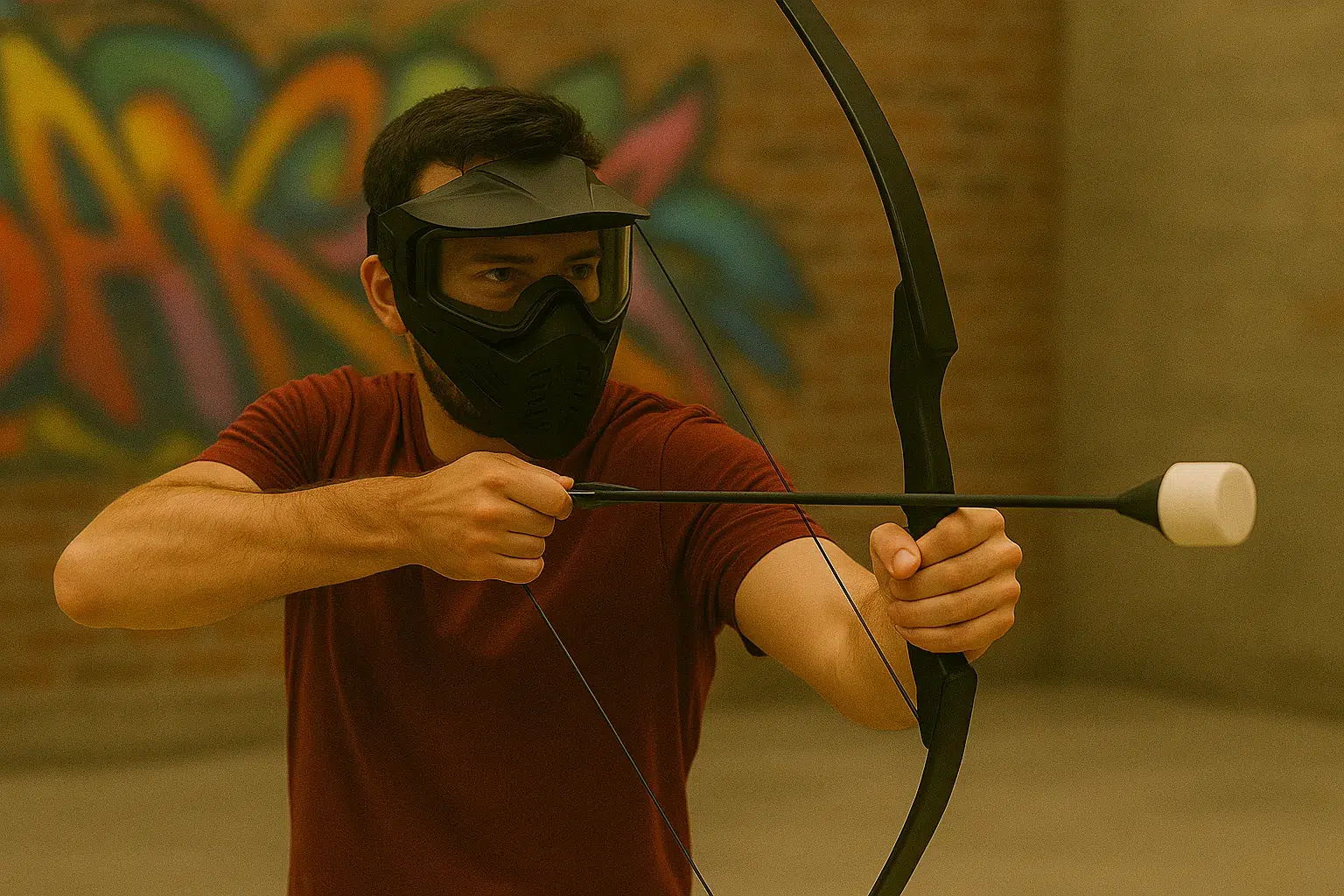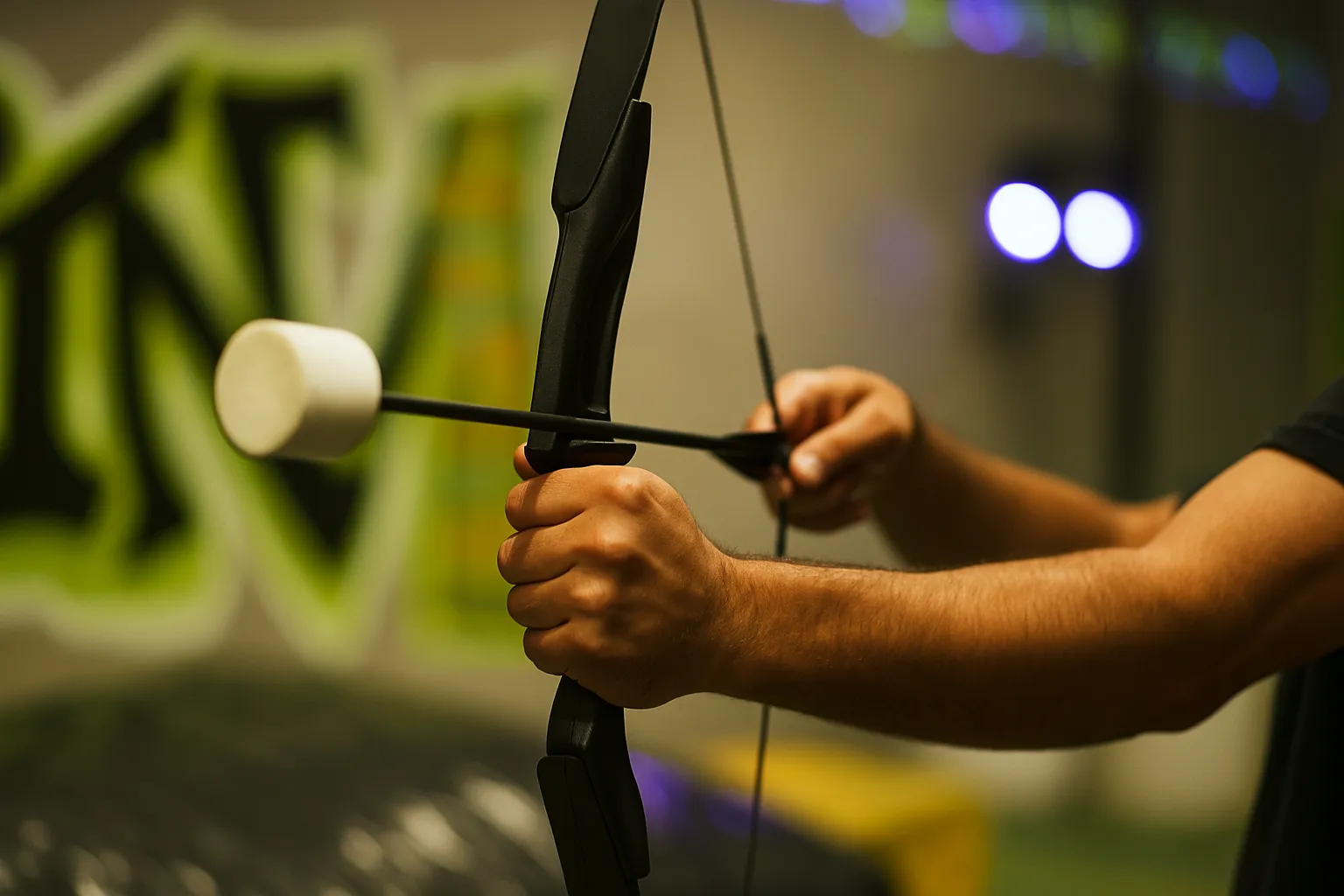At Brainy Actz, starting out in Archery Arrow Tag is exciting, but safety must always come first. For new players, having the right protective gear is just as important as learning how to play. From helmets and armguards to foam-tipped arrows and proper bow selection, each piece of equipment serves a specific purpose in keeping games fun and injury-free. This guide breaks down what beginners need, how to choose gear that fits well, and how to maintain it for long-term use.
Key Takeaways
- Protective headgear, chest pads, and armguards are essential for safe gameplay.
- Foam-tipped arrows and low-draw bows minimize injury risk and support learning.
- Correct sizing and comfort improve gear performance and player confidence.
- Pre-game safety checks help prevent accidents and equipment failure.
- Regular cleaning, storage, and maintenance extend the life of safety gear.
Identifying Essential Safety Gear for Archery Arrow Tag Beginners

Beginners must choose items that meet safety standards, are adjustable, and provide durable protection. From headgear to chest protection, every piece plays a vital role in ensuring a secure and enjoyable experience. Quality equipment reduces risk and enhances player confidence. The right setup improves gameplay by allowing free movement while minimizing injury. Attention to gear details helps players start strong and stay safe.
Mandatory Protective Headgear Selection for New Players
Protective headgear shields the face and head from foam-tipped arrows. Look for helmets with full coverage, a robust outer shell, and comfortable padding with adjustable straps to ensure a snug fit. This headgear is crucial for reducing impact-related injuries. It also helps prevent distraction by securing comfortably during rapid movements. Mesh visors or clear shields can improve visibility. Adjustable designs suit a wide range of head sizes. Soft interior linings add comfort for long matches. Proper headgear is essential for safety during play.
Armguards Your First Line of Defense in Archery Arrow Tag
Armguards protect the forearms from misfired arrows and accidental impacts. Choose guards that cover a broad area, are made of high-impact materials, and include secure fastening systems. A well-designed armguard distributes impact energy evenly while allowing flexibility. This gear helps absorb misdirected hits without limiting mobility. Breathable materials prevent overheating. Padding thickness varies based on activity intensity. Adjustable straps improve user fit. Armguards are especially useful for beginners who are learning technique.
Chest Protectors Benefits and Options for Beginner Players
Chest protectors absorb and spread the force of incoming arrows, reducing injury risks. The best protectors are lightweight, ergonomically designed, and made from durable foam with a reinforced outer layer. They should fit snugly to boost confidence during play without hindering movement. Some offer added shoulder coverage for enhanced safety. Materials should be breathable to support active movement. Most designs work comfortably under uniforms. Velcro straps allow quick adjustments. Durable models withstand repeated impacts.
Understanding Different Types of Foam-Tipped Safety Arrows
Foam-tipped arrows are central to safe gameplay. Their soft foam tips minimize impact and injury risk. Some arrows use single-density foam while others feature dual-density designs for balanced weight and safety. Regularly inspect the tips and replace them as needed to maintain protection. These arrows are ideal for high-action gameplay. Their lightweight structure improves agility. Compatible designs ensure ease of use with different bows. Proper arrow care prolongs play quality. Foam types affect bounce and travel distance.
Selecting Bows With Appropriate Draw Weight for Novices
Beginners should select bows with a lower draw weight to ease handling and minimize injury risk. Lightweight bows with adjustable draw lengths and simple release mechanisms allow players to develop proper form and control while reducing repetitive stress injuries. Low-draw bows help improve targeting without overexertion. Compact models support easier movement. Bows with soft grips enhance comfort. Adjustable tension promotes gradual skill development. Proper bow selection improves control and accuracy.
How to Choose the Right Protective Equipment for Beginner Archery Arrow Tag Players

Choosing equipment is about finding the right balance between quality, fit, and durability. New players must focus on lasting, comfortable gear that suits their practical needs. Prioritizing equipment that is both reliable and adjustable ensures a better learning curve. An informed purchase leads to better protection and enjoyment. Understanding sizing, materials, and compatibility matters. Beginners benefit from simplified gear options. Matching gear sets help streamline safety efforts. The right selection boosts early confidence in the game.
Assessing Quality and Safety Standards in Archery Arrow Tag Gear
Ensure every item meets industry safety standards and certifications. High-quality helmets, armguards, and other gear are designed to withstand repeated impacts and have undergone rigorous testing to perform reliably under pressure. Safety standards help guide smart equipment purchases. Materials should endure active matches. Look for impact-rated padding. Secure closures improve stability. Recognizable quality marks provide added assurance. Investing in certified gear prevents long-term issues. Quality gear also retains performance longer.
Finding the Correct Size for Masks and Protective Vests
Correct sizing is essential. Use manufacturer sizing charts to select masks and vests that fit snugly—neither too loose nor too tight—to prevent slippage and discomfort during play. Adjustable straps and padding are vital for an optimal fit. A well-sized vest won’t restrict breathing. Masks must allow clear vision. Sizing mistakes cause gear to shift during action. Measuring before buying helps avoid returns. Children and adults may require different gear categories. Comfort depends on accurate fit.
Material Considerations for Durability and Comfort in Beginner Gear
Protective gear should be made from lightweight, resilient materials such as high-density polyethylene and advanced foams. Moisture-wicking fabrics and breathable meshes keep players comfortable during extended play while ensuring long-lasting durability. Lightweight gear prevents fatigue. Breathable lining helps avoid overheating. Strong shells protect against repetitive impacts. Reinforced seams extend gear life. Foam density affects shock absorption. Durable gear maintains shape and flexibility. Materials should withstand cleaning and drying cycles.
Comparing Equipment Sets Versus Individual Purchases for Starting Players
Complete safety gear sets offer a cohesive look and coordinated protection at a good cost-per-item ratio, while individual items allow for customization. Beginners can start with entry-level sets and upgrade specific components like helmets as needed. Sets simplify decision-making. Custom pieces fit unique body shapes. Sets ensure full-body protection. Individual gear allows style preferences. Cost efficiency improves with bundled purchases. Entry kits often come with storage bags. Upgrades can be gradual and budget-friendly.
Where to Acquire Reliable Archery Arrow Tag Equipment for Beginners
Reliable equipment is available from major sports retailers, specialty archery stores, or directly through Brainy Actz’s venues, where staff can help beginners get properly outfitted. Look for vendors that offer warranties, customer support, and options to try-before-you-buy. Stores specializing in team-based play may offer packages. Online vendors often provide detailed reviews. Retailers with fitting services help with gear testing. Shipping insurance protects deliveries. Multiple options allow comparison shopping. Confirm return policies before purchase. High-traffic sellers offer frequent gear updates.
Ensuring Correct Fit and Adjustment of Your Archery Arrow Tag Safety Gear

Proper fit and easy adjustment of safety gear are critical. Customized fittings help maximize protection and minimize slippage or discomfort during gameplay. Well-adjusted equipment reduces distractions during matches. Players should test movement after putting gear on. Snug fits prevent exposed areas. Looseness increases injury potential. Each strap or buckle should be tested for tightness. Adjustments must not restrict breathing or flexibility. Fitting sessions before gameplay are highly encouraged.
Step-by-Step Guide to Fitting Your Archery Arrow Tag Mask
A well-fitted mask should cover the entire face without obstructing vision or breathing. Adjust the straps to ensure even contact across the forehead and chin, checking for gaps and making minor tweaks to secure a close fit. Straps should sit flat without twisting. Padding should not compress uncomfortably. Visibility must be unobstructed. Test head movement before play. Loose masks risk slipping on impact. Replace damaged buckles immediately. Recheck fit during extended games.
Adjusting Armguards for Maximum Protection and Flexibility
Ensure the armguards wrap firmly around the forearm without restricting movement. Adjust the fastening straps until the protection is secure yet allows full range of motion for quick actions during play. The guard should not rotate when flexing. No pinching or gaps should be present. Padding must cover critical areas. Players should simulate shot motion while wearing it. Fasteners must remain in place mid-game. Test for comfort under sleeves if layering. Tightness should be rechecked after breaks.
Securing Chest Protectors for Optimal Coverage
Chest protectors must be worn snugly beneath a jersey to stay in place. Adjust Velcro or straps so the protector covers the central chest and upper torso completely, providing consistent impact absorption. Avoid overly tight placement that restricts breathing. Shoulder areas must remain covered during movement. Adjust straps symmetrically for balance. Protectors should not shift when crouching. Check placement before each game. Make sure chest pads are dry to avoid slippage. Reposition immediately if misaligned during play.
Verifying Bow and Arrow Compatibility for Safe Play
Ensure that the chosen bow and foam-tipped arrows are compatible. Verify the arrow length with the bow’s specifications and check that foam tips are securely attached to prevent injury during play. Bows should not overpower the arrow’s design. Inspect nock fit before matches. Arrows should sit flush without wobbling. Test draw feel for consistency. Foam tips must not be cracked or loose. Store compatible sets together. Replace arrows that bend or twist unnaturally.
The Significance of Comfort in Safety Equipment Effectiveness
Comfort directly impacts performance. Lightweight, well-ventilated, and ergonomically designed gear prevents distraction and fatigue, ensuring players wear it consistently for maximum protection. Poorly fitted gear leads to fidgeting and lowered focus. Breathability enhances endurance in longer matches. Soft inner materials reduce skin irritation. Comfortable gear encourages full movement. Gear must allow crouching, running, and dodging. Choosing quality materials reduces pressure points. Comfortable players are more confident and reactive.
Implementing Pre-Activity Safety Inspections for Archery Arrow Tag Gear

Before each game, performing a safety inspection is essential to identify wear or damage that could compromise protection. Routine checks help prevent equipment failures during play. Team leaders should inspect all gear. Players should be trained on what to look for. Inspections include straps, padding, foam tips, and bows. Replace any compromised items immediately. Assign inspection duties for accountability. A pre-game checklist streamlines the process.
Inspecting Masks for Cracks or Damage Before Each Game
Quickly check the mask for cracks, scuffs, or weak areas. If any issues are found, repair or replace the mask immediately to ensure head protection is maintained. Focus on forehead and chin padding. Inspect the visor or mesh screen for warping. Ensure fasteners function without slipping. Press lightly to test frame strength. Avoid taping damaged areas as a long-term fix. Document recurring damage for future replacements. Always keep spare masks on hand.
Checking Foam Arrow Tips for Wear and Secure Attachment
Examine each arrow’s foam tip for secure attachment and signs of compression. Replace worn tips to keep the arrows’ cushioning properties effective and reduce injury risks. Check for looseness with a gentle pull. Look for surface splits or indentations. Foam should return to shape after light pressure. Misaligned tips affect accuracy and safety. Store arrows flat to preserve shape. Do not use arrows with exposed internal cores. Rotate arrow stock to spread wear evenly.
Examining Bow Limbs and Strings for Integrity
Inspect the bow’s limbs and string for any signs of fraying or damage. Avoid using a bow with visible wear until it has been properly serviced, ensuring consistent and safe performance. Look for cracks along limbs. Gently flex to check responsiveness. Frayed strings should be replaced promptly. Wax strings regularly to prevent dryness. Don’t bend limbs beyond their normal draw. Keep backup strings available. Use bow storage racks to avoid stress damage.
Verifying Armguard and Chest Protector Straps and Fastenings
Regularly check that all straps and fastenings on armguards and chest protectors remain secure. A brief pre-game test helps ensure that every piece of gear stays in place throughout the match. Tug straps lightly to test strength. Watch for frayed ends or slipping buckles. Ensure Velcro is clean and sticky. Double-check under layers if gear is hidden. Replace worn closures immediately. Create a checklist to track gear integrity. Keep spare parts in team kits.
Establishing a Routine Equipment Check Protocol for All Players
Implement a team-wide protocol for equipment inspections before each match. A standardized checklist promotes safety and accountability among all players. Assign responsibilities per gear type. Encourage peer-checks for overlooked issues. Maintain a log of inspection outcomes. Post instructions in locker or staging areas. Conduct random mid-season audits. Reward teams that meet safety standards. Make inspections a natural part of warmup.
Frequently Asked Questions
What type of headgear is recommended for Archery Arrow Tag?
We recommend full-coverage protective headgear with padded interiors and adjustable straps. At Brainy Actz, all players are required to wear certified helmets that provide maximum face and head protection during gameplay. Our gear is designed for comfort, secure fit, and durability, ensuring a safe and immersive experience for all ages.
How often should I inspect my safety gear?
Safety gear should be inspected before every session. A quick pre-game check to ensure masks, chest protectors, armguards, and arrows are free from cracks, frays, or loose parts is mandatory. This routine is essential to maintain safety standards and guarantee each match runs smoothly.
Is it better to buy a full equipment set or individual items?
For beginners, starting with a full equipment set is more cost-effective and ensures consistent protection across all gear. At Brainy Actz, we offer guidance on curated starter kits that meet safety requirements and fit comfortably. As you gain experience, you can personalize your setup by upgrading specific components.
How do I know if my bow and arrow set is compatible?
Compatibility depends on arrow length, draw weight, and tip design. At Brainy Actz, we ensure that all provided equipment is pre-matched for safe and effective use. Our staff will assist you in verifying that your arrows pair correctly with your bow, ensuring smooth shots and minimal safety risks during gameplay.
Can I upgrade my gear as a beginner?
Absolutely! At Brainy Actz, we encourage players to start with basic equipment and gradually upgrade based on comfort, fit, and play style. Whether you need a better-fitting helmet or a bow with adjustable draw weight, we’ll help you make safe, practical choices that grow with your skill level.
Conclusion
Archery Arrow Tag offers high-energy fun for all skill levels—but only when players are properly protected. Beginners especially benefit from reliable, comfortable gear that helps them focus on the game instead of the risks. Prioritizing fit, safety standards, and regular maintenance ensures a better playing experience and long-term participation. By taking time to understand and care for their equipment, new players at Brainy Actz can enter the field ready, confident, and well-equipped for action.

